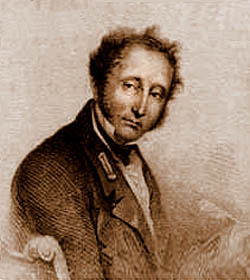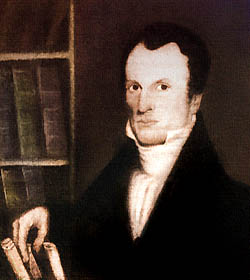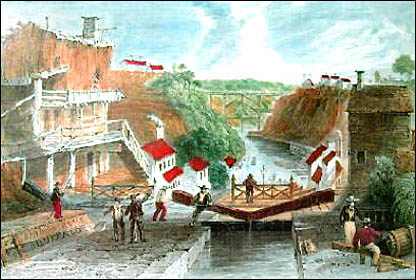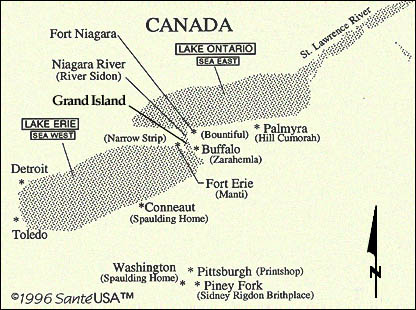 Mordecai M. Noah (1785-1851)
Mordecai M. Noah (1785-1851)
|
 Oliver H. P. Cowdery (1806 - 1850)
Oliver H. P. Cowdery (1806 - 1850)
|
MORDECAI M. NOAH and the Mormon ZION
Introduction: Who Was M. M. Noah? Part 1: 30 Ararat-Mormon Parallels
Part 2: Source Texts and Resources Part 4: M. M. Noah and the Masons
|
-- Part Three -- "Who made Noah an umpire to say whether the church of the Latter Day Saints has not as good a right to build a house at Kirtland, for worshipping the Lord, as he had to lay a stone on Grand Island, to wheedle money from the Jews to fill his own pockets?" (W. W. Phelps, 1835) Did Oliver Cowdery Know Mordecai M. Noah? Oliver the New York Pamphlet Peddler Mordecai M. Noah almost certainly knew of the New York Cowdery family, but so far no direct evidence has surfaced to link the Mormon "Second Elder" Oliver Cowdery to Mordecai M. Noah and his 1825 scheme for gathering the latter day Israel to Grand Island, New York. The indirect evidence for some association between Oliver Cowdery and Noah is tantalizing, however. As the U.S. Consul to Tunis in 1813-1814 Mordecai was instrumental in freeing several American prisoners then being held by the Barbary "pirates" at Algiers. No doubt he was well aware of the work of his predecessor in that same office in performing a similar service in helping Dr. Jonathan Cowdery of Tunbridge, Orange Co., Vermont exit a Tripolian prison in 1804. Jonathan was just one of many Americans held prisoner in Tripoli, but as a naval officer and a physician his special case provided enough interest to merit an article in Niles Register. Noah later documented the famous seige of Tripoli in a play which he wrote and staged. Also, as a New York newspaper editor and reporter, Major Noah would have been familiar with Albany City Alderman Axelred Cowdery, who delivered a major speech during the 1825 dedication ceremonies for the Erie Canal. And it is even possible that Noah crossed paths with some fo the New York City Cowdery clan -- especially so if the males of that family were involved in Freemasonry. Failing to find a direct link between Oliver Cowdery and Major Noah, a more speculative and circuitous line of evidence must be considered in its stead. The editor of the Cleveland Herald, John St.John, claimed in a Nov. 25, 1830 article that he knew Oliver when the latter had been a "a dabbler in the art of Printing, and principally occupied in writing and printing pamphlets, with which, as a pedestrian Pedlar, he visited the towns and villages of western New York and in Canada." The area in which St.John recalled the youthful Cowdery operating "some seven or eight years" before late 1830 (c. 1823-24) was on both sides of the Niagara River, the same river where Mordecai M. Noah's Grand Island development was located in 1825. For an old map of this same region (drawn nearly a decade later) see NW New York State map. Cleveland Herald editor John St.John was himself well-known in the Niagara region. The Lockport, New York Niagara Courier of Aug. 27, 1829 reprinted an article from a late August issue of the Buffalo Patriot speaking of St.John as being "well known here [Erie Co., NY] and elsewhere in the capacity of an itinerant playactor..." By an odd coincidence the same page in the Courier reprinted the Palmyra Freeman's 1829 article: "Golden Bible," relating the recent adventures of Joseph Smith, Jr. and Martin Harris. If St.John was "well known" in the Buffalo-Lockport region of western New York, it is likely that was the same area in which he became acquainted with Oliver Cowdery. Another newspaper article which spoke of Oliver Cowdery's early years was a March 1831 issue of the Lockport Balance, which called Oliver "a pamphlet pedlar and [occasionally] a journey man printer." The same article was reprinted in the Mar. 16, 1831 issue of the Guernsey Times of Cambridge, Ohio and in the Daily Albany Argus of June 21, 1831. It may be significant that the Lockport Balance article writer (probably editor Orsamus Turner) recalled Cowdery as being more than just a "dabbler" in printing (as John St.John remembered him) but rather, a trained printer who could have run off pamphlets of his own on practically any job-shop press he could gain access to. It seems likely that Oliver Cowdery was writing, printing, and distributing pamphlets in the Niagara region at just about the same time that Mordecai M. Noah was buying land on Grand Island. The question naturally arises -- did Oliver learn of Noah's plans and perhaps even help to publicize them? In later years Cowdery was certainly aware of Noah and his work. In fact, Cowdery's close personal friend, W. W. Phelps, took the trouble to respond to an editorial Noah had written, complaining about the Mormons and their "House of the Lord" at Kirtland. Phelps' letter on this matter was published in the Dec. 1835 issue of the LDS newspaper The Messenger and Advocate. It is even possible that Oliver Cowdery's dedication of the LDS Temple cornerstone placed at Independence, Missouri in 1831 was copied somewhat from Noah's own dedication of a cornerstone (of a Masonic or Jewish Temple?) for his Grand Island project.  Lockport, Niagara Co. NY in the 1820s When Did Oliver Cowdery First Come to New York? In his recent article, "Oliver Cowdery's Vermont Years and the Origins of Mormonism" (BYU Studies, April 2000), Larry E. Morris has this to say about Oliver Cowdery's youthful relocation to New York State: "Oliver left Vermont around 1825, but the exact year is not known. Lucy [his half-sister] claims he left when he was twenty, and he turned twenty in October 1826. However, Lucy mistakenly states that Oliver was born in 1805, so she could have thought that he turned twenty in 1825." Lucy Cowdery Young's recollection of her half-brother having left Vermont for New York "when he arrived at the age of twenty" is recorded in a letter she wrote to her late brother-in-law's son, Brigham H. Young, on March 7, 1887. The information in that letter was used by Andrew Jenson and later Mormon historians in establishing a hazy chronology for Oliver's early years, before he is known to have lived with the Joseph Smith, Sr. family in Manchester, Ontario Co., New York, beginning no later in the fall of 1828. If Lucy's memory is strictly relied upon, it would mean John St.John's calculation of Oliver's being in western NY in 1823 or 1824 was off by at least a year. There may however be a solution to this seeming conflict in dates which would allow both John St.John and Lucy Cowdery Young to be correct in their respective memories of the young Oliver in New York. In his 1950 seminal history of western New York, The Burned-Over District, author Whitney R. Cross states: "Vermonters simultaneously moved around the Adirondacks, populating stretches of the flat St. Lawrence Valley on their way to the Black River and the eastern shores of Lake Ontario.... The voyager could always locate former friends, since many men who went west for the summer land-clearing and back east for the winter several times before their final trip constantly carried letters and messages... Those who went west were, first of all, younger sons... The youths, too, had greater ambition and a lust for adventure... Although two-thirds of all Vermonters were twenty-five or under in 1800, the emigrants were, on the average, still younger" (pp. 5-6). The emigration Cross envisions for the early 1800s is one in which very youthful Vermont-born pioneers spent a few summers working out in central or western New York, before packing up and moving to that new country for good. With his older brothers already living in western New York, the teen-aged Oliver would have had every incentive to follow the newly-built Erie Canal or the old Genesee Road westward out of economically depressed Vermont and into the frontier region where his siblings were located. He may well have joined the seasonal flow of New Englanders to western New York several years in a row before making his permanent relocation in that region in about the spring of 1823 -- when he was nearing twenty years of age. Did Oliver First Move to the Niagara Area? Oliver's half-sister also stated in her 1887 letter: "...he [Oliver Cowdery] went to the State of New York where his older brothers were married and settled..." This seems to indicate that the youthful Oliver moved in with one of his older brothers who were already residents of the Empire State. In 1823-25 the older Cowdery brothers living in New York State were: (1) Lyman, b. 1802, who lived in Arcadia or Lyons, Wayne Co., (2) Warren, b. 1788, who lived in LeRoy, Genesee Co., but who had relocated temporarily to the Freedom-Farmersville area of Cattaraugus Co., and Stephen, b. 1781, who was living at Buffalo by the early 1830s. Two other brothers, Dyer (b. 1793) and Erastus (b. 1796) had also "gone west" before Oliver left Vermont. Dyer probably lived near Warren's home in Cattaraugus Co., while Erastus had moved all the way to Youngstown, Trumbull Co., Ohio and was living six or seven miles from the Rev. Sidney Rigdon by 1820. Oliver's brother, Stephen F. Cowdery, lived in Buffalo NY as early as 1835. Oliver mentions his having a house "demolished" by "wind and water" there at about the time Oliver visited that city and related his experience there in a letter written to Warren A. Cowdery on Nov. 22, 1835 (original in the Cowdery Letters at the Huntington Library, San Marino, CA). A "Suthen F." Cowdery was living in Rochester, NY in 1830 (according to the Census for that year) and he was almost certainly Oliver's brother, Stephen F. This older brother died in 1848, whereabouts unrecorded. John St.John's recollection of Oliver Cowdery having been in western NY was early as 1823 or 1824 and his having been a peddler there and in Canada is consistent with Oliver's possibly living temporarily with is older brother Stephen in the region southwest of Rochester. It is certainly possible that Oliver was living in that area as late as 1825-26. And if he was, he would have certainly heard of Mordecai M. Noah's 1825 plan to gather the modern "Israelites" on Grand Island in the Niagara River. It is even possible that some of Oliver's pamphleteering was somehow related to Noah's publicizing of the Grand Island project. Besides his brethren the Jews, Noah also expected American Indians and Gentiles to participate in his visionary development. In his Sept. 15, 1825 "Proclamation to the Jews," Major Noah stated that the Indians were "in all probability the descendants of the lost tribes of Israel" and promised that "measures will be adopted to make them sensible of their origin." This, of course, was precisely the belief Oliver Cowdery held at about that same time; in fact, it formed the basis and incentive for his arduous 1830 pedestrian proselytizing mission to several Indian tribes (then living near Grand Island, in northern Ohio, and along the west bank of the Missouri River across from the frontier settlement at Independence). Cowdery was apparently well-suited for his 1830 pedestrian book-peddling mission (as was his tinware peddler companion Parley P. Pratt) and it may be in order to seriously wonder whether he had not received earlier experience in that very line of work -- perhaps by peddling tracts to Canadians and Indians, advertising opportunities such as Major Noah's "Israelite gathering" plan. Oliver and Warren Cowdery in LeRoy New York In a interview published in the Saints' Herald of June 1, 1881, William Bryant, an old neighbor of Oliver Cowdery in western NY, recalled, "He (Cowdery), was strong against the Masons; he helped to write Morgan's book, they said." If the young Oliver was really "strong against the Masons," he may have felt less than comfortable in living with his brother Lyman in Wayne Co. in the mid-1820s. Danford Booth, another Cowdery neighbor quoted in the same 1881 article, said, "[Lyman?] Cowdery was a strong Mason, so they all said; that is all the religion he had." A "Warren C. Cowdery" was listed in the 1820 Census as living with his household in LeRoy, Genesee Co., NY. As some of Warren A Cowdery's children are listed in various genealogical records as having been born at LeRoy in the early 1820s, it seems that Oliver's brother was living there during the early 1820s, but with a temporary absence during 1823-25, when Warren and his family resided in the Freedom-Farmersville area in nearby Cattaraugus Co. Oliver may have even occupied Warren's LeRoy residence while that brother was temporarily away during 1823-25. The possibility that Oliver Cowdery lived with or near his brother Warren in LeRoy -- and that he assisted the anti-Masonic writer William Morgan (either in that town or nearby Batavia) -- is strengthened by something Morgan's widow related in a sworn statement dated Sept. 22, 1826. Lucinda Morgan there said: "That the papers [of her husband William Morgan]... were numerous, and formed a very large bundle; they were written in the handwriting of [her] husband, excepting a few, which were written by a person who sometimes assisted her husband by copying, or taking down as he dictated to him" (statement reprinted in Samuel D. Greene's 1870 book, The Broken Seal..., pp. 89-90. Lucinda Morgan's description of this unnamed amanuensis' work is precisely the same as the task Oliver Cowdery later carried out for Joseph Smith, Jr. -- copying down the dictated words for a controversial manuscript book, destined to be published by a newspaper print shop in upstate New York. Morgan was accepted into the Royal Arch Masonic Lodge in LeRoy on May 23, 1825. If Oliver Cowdery was indeed involved with Morgan and his associates in anti-Masonic plotting, that association probably began some time after that date.  Wm. Morgan writing Illustrations of Masonry (Anti-Masonic Almanac, 1829) Most biographers of Oliver Cowdery agree that he was living in Wayne Co. New York with or near his brother Lyman by 1827-28. Dan Vogel places him "at his brother's store at Lyons, Wayne County, New York, until about late 1828, when he went to Manchester, New York, in order to replace his brother Lyman as school teacher there." (Early Mormon Documents Vol 2 p. 397. According to Mary Mehling's 1911 Cowdrey Genealogy, Lyman was a "lawyer and judge" as well as "member of [the NY State] Legislature two terms" (p. 172). There is no record of Lyman either owning a store or being a school teacher at any time in his life. Vogel has perhaps confused some family recollection of Oliver's having temporarily worked in his brother Warren's apothecary business (in Freedom or LeRoy?) with his probable living with Lyman or their parents, William and Keziah, in Arcadia, Wayne Co., New York c. 1827-28. If Oliver was involved in William Morgan's 1826 project to expose Freemasonry, it is probable that he left the LeRoy-Batavia region after Morgan's abduction later that year. One person who was perhaps in a position to know of Oliver Cowdery's suspected activities in the LeRoy-Batavia area in the mid-1820s was Charles B. Thompson. Thompson was a printer in LeRoy who became editor of the LeRoy Gazette in June of 1840 (according to Frederick Follett's 1845 History of the Press in Western New York pp. 59-62 -- Follett himself was editor of Batavia's Spirit of the Times from 1825 to 1840). Charles B. Thompson was baptized a Mormon c. 1839, then wrote and published his Evidences in Proof of the Book of Mormon in 1841 at Batavia. Thompson later became the leader of a Mormon splinter group, publishing periodicals in Manona Co., Iowa and later in Saint Louis, Missouri. None of his writings are known to provide any unique information regarding the elusive Oliver Cowdery, however. Thompson's 1841 Evidences quotes from Elias Boudinot and Josiah Priest, both of whom wrote on the same old notion that so inspired Mordecai M. Noah -- that the American Indians might be descendants of Israelites. Thompson probably also knew of the writings of the Rev. Ethan Smith, who published editions of his View of the Hebrews in 1823 and 1825 in Oliver Cowdery's home area of Poultney, Rutland Co., Vermont. Josiah Priest quoted Ethan Smith's book extensively in his own 1826 volume The Wonders of Nature and Providence Displayed. However, Thompson either knowingly or unknowingly avoided mentioning Priest's 1826 work and instead boasted that Priest's 1833 book on the same subject matter "was not published until A. D. 1833, three years after [the 1830 Book of Mormon]..." (p. 98, cf. p. 146). Thompson was in the right place, at the right time, with the right interests to have met and known Oliver Cowdery, Alvah Beaman, William Morgan, Morgan's wife Lucinda, and Lucinda's second husband, George W. Harris of Batavia. Oliver, Lucinda, George, Alvah, and Charles all became Mormons before 1840 and William Morgan himself was probably something of a proto-Mormon. Writing in 1883, Dr. Robert Morris. a noted Masonic historian, claimed that, "He [William Morgan] had been a halfway convert of Joe Smith, the Mormon, and had learned from him to see visions and dream dreams." (William Morgan, p. 196). Michael W. Homer, in his 1994 article "Similarity... Relationship Between Freemasonry and Mormonism," argues that such a conversion was "impossible since Morgan disappeared in 1826 and the Mormon church was not organized until 1830... There is no documentation for this claim..." (Dialogue, 27:3, p. 19). Morris did not however, say that William Morgan had been a convert to "Mormonism," but rather to Joseph Smith himself -- or to Smith's early reputation as a vision-seer. Given the fact that Morgan's widow, Lucinda, later became one of Smith's earliest plural wives, at Far West Missouri, and that Oliver Cowdery was recalled to have been an associate of Morgan's, perhaps there WAS some association between Morgan, Cowdery, and Smith. If so, another probable link in this unlikely chain could have been divining rodsman and proto-Mormon, Alvah Beaman of Livonia, Livingston Co., New York. Beaman lived about half-way between Morgan's Batavia and Smith's Manchester during the period encapsulating the "William Morgan Affair." One More Oddity The early Mormons accepted as a matter of fact the notion that a portion of the ancient "Israelite" civilizations spoken of in the Book of Mormon existed in the Americas, and in particular, in the eastern United States and Canada. A writer like Charles B. Thompson (who in 1841 equated the "mound-builders" of the Ohio and Mississippi valleys with the Mormon 'Nephites") could have easily been persuaded that the Book of Mormon's "Sea East" was the modern Lake Ontario and its "Sea West" was Lake Erie. While official Mormon periodicals continued to publish the mound-builders=Nephites notion for decades after Thompson's day, in more recent times most Mormons depicting Book of Mormon geographies have abandoned the Great Lakes area as a center for the supposed ancient Nephite civilization. One LDS author who has bucked that trend is Delbert W. Curtis, who has written several books on the subject. In his 1993 Christ in North America Curtis argues that the modern Niagara River, on the boundary between NY and Ontario, represents the Book of Mormon's key waterway: the River "Sidon." This geographic identification naturally makes Grand Island in the Niagara River a potentially important piece of Book of Mormon real estate. If Curtis' interpretation is the correct one, Grand Island might even be parts of the Mormon book's "Lands of Nephi and Zarahemla" which "were nearly surrounded by water..." Another writer on Mormon roots who substantially agrees with Curtis' geography is Byron Marchant. His map of this same region is reproduced below.  The above Map was adapted from Byron Marchant's Original see also: an old map of this same area Is it possible to bring all these diverse historical threads together to form a single pattern? Do the stories of William Morgan, George W. Harris, Charles B. Thompson, and Alvah Beaman all somehow overlap that of the biographically evasive Mormon "Second Elder," Oliver H. P. Cowdery? Is their some yet undiscovered link between the 1800-02 Nathaniel Wood Money-digger rodsmen of Middletown, Vermont, Ethan Smith's 1823 writings on the "Red Sons of Israel," Mordecai M. Noah's 1825 Gathering of Israel, the 1826 abduction of William Morgan, and Oliver Cowdery's early cooperation with Joseph Smith, Jr. in the bringing forth of the Book of Mormon? Time (and laborious researching for the necessary documentation) alone will tell. PART 4: Noah & the NY Masons |
Return to Top of This Page
Return to: Spalding Research Project (Introduction)